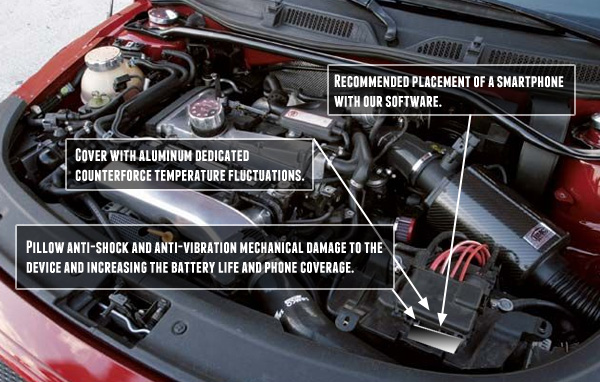
Audi TT Mk1 8N GPS Tracking
Track your TT Mk1 8N for free and visualize it on map
Produced to: 2006
How to track your favourite Audi - model TT Mk1 8N in realtime for free ?
Producer remarks about this particular model
Known also as Typ 8N is a two-door sport car produced in Germany. Internal mounted combustion engine was used with both front-wheel drive and 'quattro' on-demand four-wheel drive. Originally 1.8-litre inline four-cylinder 20-valve was used. A few high-speed accidents were reported as the TT allows to speed up to 180 kilometers per hour (110 mph).Our product description
We are offering you completely free of charge our GPS car tracking solution in real time. The only thing you need to do is to install smartphone with Android inside your vehicle with our awesome application on board
If you want to track your Audi TT Mk1 8N in real time you have to do the following :
1. Download Free Car Tracking Application for TT Mk1 8N application from Google Play
2. Create free account on spysat.eu (for example johndoe) - here is detailed instruction
3. Define Device endpoint for each vehicle you want to track - give friendly name of your TT Mk1 8N and PIN (some random will be provided - you can change it if you want)
4. Run SpySat mobile application on the smartphone and type there your LOGIN from SpySat (ex. johndoe) and PIN (from point 3.)
5. Install your smartphone inside the car
6. Enjoy watching position of your car at spysat.eu site.
7. Provide stable power supply - spysat app consumes some energy.
Best options to install smartphone inside Audi TT Mk1 8N

Recommended placement of a smartphone with our software. Cover with aluminum dedicated counterforce temperature fluctuations. Pillow anti-shock and anti-vibration mechanical damage to the device and increasing the battery life and phone coverage.
To permanently mount a smartphone in your Audi TT Mk1 8N, you'll need a few tools and some knowledge of electrical engineering. Here's a step-by-step guide to help you through the process:**Materials:**
* A double-sided adhesive tape or a 3M VHB tape
* Screwdriver ( Phillips head #2 )
* Small screwdriver
* Wire stripper
* Crimping tool
* RJ45 wire connector
* Battery terminal bolt
* Waterproof casing or container (optional)
* Smartphone with GPS enabled
**Step 1: Disconnect the Negative Battery Cable**
Before you can mount your smartphone, you need to disconnect the negative battery cable from the engine. Refer to your car's manual for proper disconnection and reconnection procedure. Once disconnected, wait a few minutes for any residual charge to drain from the battery before moving on.
**Step 2: Remove Existing Parts**
Remove the existing GPS unit or any other parts that may interfere with mounting your smartphone. Depending on the model of your car, you may need to remove the dashboard, air vents, and/or shift lever. Refer to your car's manual for guidance on removing these parts.
**Step 3: Prepare the Smartphone**
Position your smartphone in the desired location within the vehicle, considering factors such as visibility and ease of use. You may need to use a mount or holder specifically designed for smartphones. Make sure that the GPS function is enabled and working properly. If you plan on using any additional apps, install them now.
**Step 4: Connect the Smartphone**
Using an RJ45 wire connector and crimping tool, connect the Ethernet jack of your smartphone to the car's electrical system through a pigtail cable (available at most electronics stores). Use a wire stripper to strip the ends of the cables so they fit snugly into the connectors. Secure each end with pliers or wire tape to prevent accidental disconnects.
**Step 5: Connect to the Battery**
Using a small screwdriver and the Phillips head #2, remove the battery terminal bolt from the negative battery cable. Clean the threads of the bolt with a clean cloth and apply Loctite Thread Sealant around them (enough to fill the threads but not overflow). Reinstall the bolt into the terminals and tighten it by hand only.
Next, use the crimping tool to connect an RJ45 connector onto each end of a piece of wire that connects the battery's negative terminal with your car's electrical system. Use pliers or wire tape to secure each end of the cable.
**Step 6: Mount the Smartphone**
Using double-sided adhesive tape or 3M VHB tape, mount your smartphone inside the vehicle. Position it in a location that is both visible and easily accessible. Attach any additional components or accessories as necessary. If you're using waterproof casing or container, secure them around your smartphone before mounting it.
**Step 7: Test Everything**
Reconnect the negative battery cable to the engine and test all connections to ensure they are working properly. Turn on your GPS tracking application and verify that your smartphone is connected with a permanent direct connection to the battery system. If everything works correctly, you should have a fully functioning GPS tracker that you can use for various applications.
As for useful maintenance tips:
* Regularly clean the exterior of your car to prevent corrosion and maintain its appearance.
* Check the tire pressure regularly and keep them inflated to the recommended level.
* Replace any worn or damaged parts as soon as possible to ensure safe driving conditions.
For additional information and free apps related to GPS tracking, visit our website.
Users opinions and questions
Great car. I drive him from the news, a couple of months. It's exactly as I choose
I am happy with the purchase Audi TT MK1 8n. This car already bought 5 years ago and still did not complain about any failures or defects.
The look is quite specific and that's why I like it. I love the interior of this car which is still in the plet - a miracle.
With the heavy foot of a truly sporty driving experience, with calmer ride it is very quiet, comfortable.
The only notable flaw in this car is poor visibility through the windshield. Here is minus Audi TT Mk2 8N.
Soon I will buy a new model, and this will give to his wife. Calmly he can handle and even replace the wheel. I already did, so even a delicate little woman will cope with the change of tires in the Audi TT Mk1 8N.
Frequently Asked Questions:
What is the recommended maintenance schedule and service intervals for a 2001 Audi TT Mk1 8N with a 1.8T engine?
The recommended maintenance schedule and service intervals for a 2001 Audi TT Mk1 8N with a 1.8T engine are as follows:**Every 15,000 km or 12 months (whichever comes first):**
- Check engine oil level and top up if necessary.
- Check coolant level in radiator and top up if necessary.
- Check brake fluid level and top up if necessary.
- Check transmission fluid level (automatic) and top up if necessary.
- Inspect air filter and replace if necessary.
- Inspect wiper blades and replace if necessary.
- Lubricate door hinges, latches, and other mechanical parts as needed.
**Every 30,000 km or 24 months (whichever comes first):**
- Replace engine air filter.
- Inspect brake pads and rotors for wear and replace if necessary.
- Check suspension components and lubricate as needed.
- Inspect exhaust system for leaks or damage and repair as necessary.
**Every 60,000 km or 48 months (whichever comes first):**
- Replace spark plugs.
- Change engine oil and filter.
- Inspect fuel injection system and clean if necessary.
- Inspect timing belt for wear and replace if necessary. This interval may vary depending on the specific model year of your Audi TT, so always refer to your owner's manual for recommended maintenance intervals.
Remember that these are general guidelines, and it's essential to consult your vehicle's owner's manual or contact a certified Audi dealership or mechanic to get personalized advice based on your driving habits and specific model year.
What are the common issues associated with the timing chain and tensioner on a 2006 Audi TT Mk1 8N, and how can they be diagnosed and repaired?
The timing chain and tensioner are crucial components in the engine of your 2006 Audi TT Mk1 8N. They ensure that the camshafts and crankshafts maintain proper synchronization, which is essential for the engine to function correctly. Over time, these components can wear out or fail, leading to several common issues:1. Rattling noise from the engine compartment: This is often one of the first signs that something may be wrong with your timing chain or tensioner. The rattling sound usually occurs when you start your car or drive at lower speeds, and it can worsen as the engine heats up.
2. Engine misfires: If the timing chain or tensioner is not functioning correctly, it can cause the engine to misfire. This results in poor performance, reduced fuel efficiency, and potentially damage to other components if left unaddressed.
3. Check Engine Light: The vehicle's computer system may detect a problem with the timing chain or tensioner and trigger the Check Engine Light. It is essential to have this light diagnosed by a professional mechanic as soon as possible to prevent further damage.
4. Difficulty starting the engine: A failed timing chain or tensioner can cause your car to struggle when you try to start it. This could be due to a lack of compression in the cylinders, which may require a full inspection and potential repair.
5. Excessive oil consumption: The timing chain and tensioner rely on engine oil to lubricate and keep everything running smoothly. If there is a problem with these components, your car may consume more oil than usual, leading to low oil levels and potential engine damage.
Diagnosing and repairing timing chain and tensioner issues:
1. Visually inspect the timing chain guide rails for wear or damage. If you notice any irregularities, it could indicate that the timing chain is beginning to stretch, which would require replacement.
2. Check the tensioner for excessive play or noise. A faulty tensioner can cause the chain to slip, leading to engine misfires and other performance issues. Replacing a failing tensioner is essential for maintaining proper timing.
3. Inspect the timing chain guide rails for debris or foreign objects that may be causing damage. Cleaning the guides and removing any obstructions can help prevent further wear on the chain and tensioner.
4. Use an OBD2 scanner to read any diagnostic trouble codes (DTCs) related to the engine's timing system. These codes can provide valuable information about potential issues with the timing chain, tensioner, or other components.
5. Have a professional mechanic perform a comprehensive inspection of your car's engine and timing system. They will be able to identify any problems with the timing chain, tensioner, or other related components and recommend the appropriate course of action.
In conclusion, addressing issues with your 2006 Audi TT Mk1 8N's timing chain and tensioner is crucial for maintaining optimal engine performance and preventing costly damage. Regular maintenance and inspections can help identify potential problems early on, allowing you to take action before more extensive repairs are necessary.